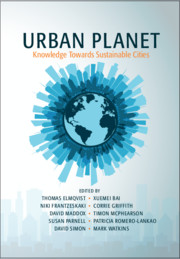Crossref Citations
This Book has been
cited by the following publications. This list is generated based on data provided by Crossref.
Elmqvist, Thomas
Siri, José
Andersson, Erik
Anderson, Pippin
Bai, Xuemei
Das, Pranab Kishore
Gatere, Tatu
Gonzalez, Andrew
Goodness, Julie
Handel, Steven N.
Hermansson Török, Ellika
Kavonic, Jessica
Kronenberg, Jakub
Lindgren, Elisabet
Maddox, David
Maher, Raymond
Mbow, Cheikh
McPhearson, Timon
Mulligan, Joe
Nordenson, Guy
Spires, Meggan
Stenkula, Ulrika
Takeuchi, Kazuhiko
and
Vogel, Coleen
2018.
Urban tinkering.
Sustainability Science,
Vol. 13,
Issue. 6,
p.
1549.
Ilieva, Rositsa T.
and
McPhearson, Timon
2018.
Social-media data for urban sustainability.
Nature Sustainability,
Vol. 1,
Issue. 10,
p.
553.
Andersson, Erik
Langemeyer, Johannes
Borgström, Sara
McPhearson, Timon
Haase, Dagmar
Kronenberg, Jakub
Barton, David N
Davis, McKenna
Naumann, Sandra
Röschel, Lina
and
Baró, Francesc
2019.
Enabling Green and Blue Infrastructure to Improve Contributions to Human Well-Being and Equity in Urban Systems.
BioScience,
Vol. 69,
Issue. 7,
p.
566.
Bohle, Martin
and
Preiser, Rika
2019.
Exploring Geoethics.
p.
71.
Childers, Daniel L.
Bois, Paul
Hartnett, Hilairy E.
McPhearson, Timon
Metson, Geneviève S.
Sanchez, Christopher A.
Zak, Donald R.
and
Hellmann, Jessica J.
2019.
Urban Ecological Infrastructure: An inclusive concept for the non-built urban environment.
Elementa: Science of the Anthropocene,
Vol. 7,
Issue. ,
Elmqvist, Thomas
Gatzweiler, Franz
Lindgren, Elisabet
and
Liu, Jieling
2019.
Biodiversity and Health in the Face of Climate Change.
p.
411.
Elmqvist, Thomas
Andersson, Erik
Frantzeskaki, Niki
McPhearson, Timon
Olsson, Per
Gaffney, Owen
Takeuchi, Kazuhiko
and
Folke, Carl
2019.
Sustainability and resilience for transformation in the urban century.
Nature Sustainability,
Vol. 2,
Issue. 4,
p.
267.
Elmqvist, Thomas
2019.
City Policies and the European Urban Agenda.
p.
173.
Lehmann, Steffen
2019.
Urban Regeneration.
p.
1.
Lausch, Angela
Baade, Jussi
Bannehr, Lutz
Borg, Erik
Bumberger, Jan
Chabrilliat, Sabine
Dietrich, Peter
Gerighausen, Heike
Glässer, Cornelia
Hacker, Jorg
Haase, Dagmar
Jagdhuber, Thomas
Jany, Sven
Jung, András
Karnieli, Arnon
Kraemer, Roland
Makki, Mohsen
Mielke, Christian
Möller, Markus
Mollenhauer, Hannes
Montzka, Carsten
Pause, Marion
Rogass, Christian
Rozenstein, Offer
Schmullius, Christiane
Schrodt, Franziska
Schrön, Martin
Schulz, Karsten
Schütze, Claudia
Schweitzer, Christian
Selsam, Peter
Skidmore, Andrew
Spengler, Daniel
Thiel, Christian
Truckenbrodt, Sina
Vohland, Michael
Wagner, Robert
Weber, Ute
Werban, Ulrike
Wollschläger, Ute
Zacharias, Steffen
and
Schaepman, Michael
2019.
Linking Remote Sensing and Geodiversity and Their Traits Relevant to Biodiversity—Part I: Soil Characteristics.
Remote Sensing,
Vol. 11,
Issue. 20,
p.
2356.
Wolfram, Marc
Borgström, Sara
and
Farrelly, Megan
2019.
Urban transformative capacity: From concept to practice.
Ambio,
Vol. 48,
Issue. 5,
p.
437.
Koch, Florian
Krellenberg, Kerstin
Reuter, Klaus
Libbe, Jens
Schleicher, Katharina
Krumme, Klaus
Schubert, Susanne
and
Kern, Kristine
2019.
Wie lassen sich die Sustainable Development Goals umsetzen?.
disP - The Planning Review,
Vol. 55,
Issue. 4,
p.
14.
Evans, James
2019.
Governing Cities for Sustainability: A Research Agenda and Invitation.
Frontiers in Sustainable Cities,
Vol. 1,
Issue. ,
Reyers, Belinda
and
Selig, Elizabeth R.
2020.
Global targets that reveal the social–ecological interdependencies of sustainable development.
Nature Ecology & Evolution,
Vol. 4,
Issue. 8,
p.
1011.
Onaindia, Miren
and
Fisher, Joshua
2020.
Life on Land.
p.
1.
Pereira, Laura
Drimie, Scott
Zgambo, Olive
and
Biggs, Reinette
2020.
Planning for change: Transformation labs for an alternative food system in Cape Town, South Africa.
Urban Transformations,
Vol. 2,
Issue. 1,
Ingaramo, Roberta
and
Pascale, Luca
2020.
An Interpretative Matrix for an Adaptive Design Approach. Italian School Infrastructure: Safety and Social Restoration.
Sustainability,
Vol. 12,
Issue. 20,
p.
8354.
Kosovac, Anna
Acuto, Michele
and
Jones, Terry Louise
2020.
Acknowledging Urbanization: A Survey of the Role of Cities in UN Frameworks.
Global Policy,
Vol. 11,
Issue. 3,
p.
293.
Pereira, Laura
Asrar, Ghassem R.
Bhargava, Rohan
Fisher, Laur Hesse
Hsu, Angel
Jabbour, Jason
Nel, Jeanne
Selomane, Odirilwe
Sitas, Nadia
Trisos, Christopher
Ward, James
van den Ende, Mandy
Vervoort, Joost
and
Weinfurter, Amy
2021.
Grounding global environmental assessments through bottom-up futures based on local practices and perspectives.
Sustainability Science,
Vol. 16,
Issue. 6,
p.
1907.
Saraceno, Martín
Gómez Lugo, Sebastián
Ortiz, Nicolás
Gómez, Bárbara M.
Sabio y García, Carmen A.
Frankel, Nicolás
and
Graziano, Martín
2021.
Unraveling the ecological processes modulating the population structure of Escherichia coli in a highly polluted urban stream network.
Scientific Reports,
Vol. 11,
Issue. 1,





